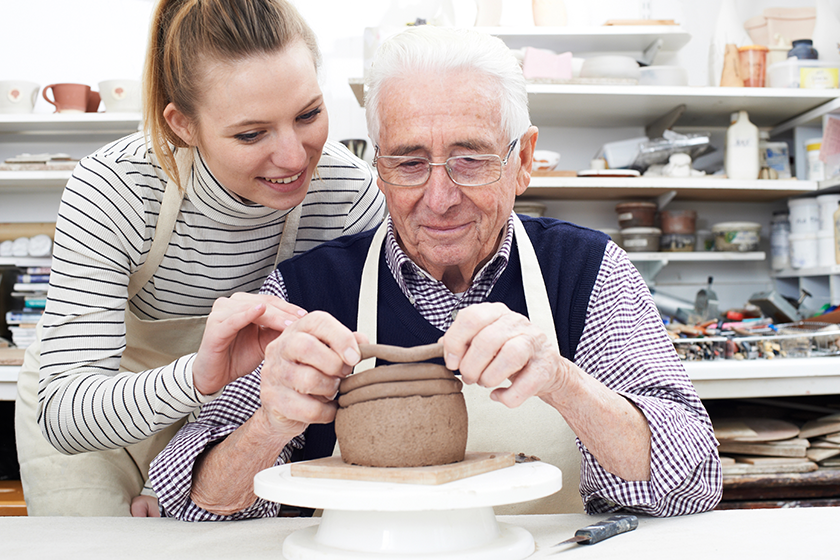Art therapy offers a meaningful and accessible way for seniors to maintain their physical and mental well-being. Through the creative process of making art, this therapeutic approach encourages expression, enhances cognitive function, and fosters emotional connections.
By engaging in activities like painting, drawing, or sculpting, seniors can experience the numerous benefits that art therapy for seniors provides, from improved motor skills to a greater sense of community and belonging. This article explores how art therapy contributes to a richer, more fulfilling life as people age.
What is Art Therapy?
Art therapy is a form of expressive therapy that uses the creative process of making art to improve physical, mental, and emotional well-being. This therapeutic approach doesn’t require any prior artistic skills, making it accessible to everyone. Through painting, drawing, sculpting, or other art forms, you or your loved one can express emotions, manage stress, and enhance cognitive function.
Physical Benefits of Art Therapy
Engaging in art therapy provides numerous physical benefits. Creating art often involves fine motor skills, which are essential for maintaining hand-eye coordination and dexterity. Activities like painting or sculpting require you to use different muscles in your hands and arms, keeping them active and reducing the stiffness that can come with age.
Additionally, the physical act of creating art can be a gentle form of exercise. Moving around to gather materials, reaching across a canvas, or kneading clay can all contribute to maintaining mobility and flexibility. These activities are particularly beneficial for you if you are looking to maintain or improve your physical abilities in a non-strenuous way.
Mental Engagement Through Creative Expression
Art therapy is also a powerful way to keep the mind engaged. As you age, it’s important to find activities that challenge the brain and stimulate cognitive functions. Art therapy encourages problem-solving, decision-making, and memory recall. Whether you are deciding which colors to use or how to structure a piece, these decisions keep the mind active and alert.
Moreover, art therapy can be especially effective in improving cognitive function in those dealing with memory loss or cognitive decline. The process of creating art can trigger memories and emotions, offering a meaningful way to connect with the past and stay mentally sharp.
Emotional and Social Connections
Art therapy also plays a significant role in emotional well-being. Expressing emotions through art can be cathartic, helping to release feelings that may be difficult to articulate in words. This emotional release can lead to reduced stress and anxiety, creating a sense of peace and relaxation.
Furthermore, participating in art therapy in a group setting provides an opportunity for social interaction. Engaging with others in a shared creative process can foster a sense of community and belonging. These connections are vital for emotional health, especially in later years when feelings of isolation may arise.
Enhancing Quality of Life in Assisted Living
Art therapy contributes to a higher quality of life in Assisted Living communities by offering a fulfilling and enjoyable time to spend. The creative process fills the day with purpose and provides a way to explore new talents and passions. For you or your loved ones, this can be a source of great joy and satisfaction.
Moreover, art therapy can be tailored to meet individual needs and preferences, making it a versatile activity that can suit various interests. Whether you prefer painting landscapes, sculpting figures, or crafting unique items, art therapy offers a personalized experience that can bring a sense of accomplishment and pride.
Long-Term Benefits of Art Therapy
The benefits of art therapy extend beyond immediate physical and mental engagement. Over time, regular participation in art therapy can lead to improved overall health. It can help manage chronic pain, lower blood pressure, and even boost the immune system. Mentally, it can slow the progression of cognitive decline and enhance mood, leading to a more positive outlook on life.
Emotionally, the sense of fulfillment and connection fostered through art therapy can contribute to long-term happiness and contentment. This holistic approach to well-being ensures that you or your loved ones can enjoy a richer, more vibrant life as you age.
Exploring Art Therapy Options in Retirement Community
As you consider a retirement community, it’s important to explore the available activities and events, including art therapy. This form of therapy is not only a fun and creative way to spend time but also a crucial element in maintaining both physical and mental health. When evaluating potential communities, ask about their art therapy programs and how they can be tailored to meet individual needs.
At our Independent Living community, we are committed to offering engaging activities that enhance your quality of life. Art therapy is one of the many ways we support your physical and mental well-being, ensuring that you remain active and fulfilled. We invite you to learn more about how our community can provide a vibrant and enriching environment for you or your loved ones. Contact us today to learn more about our tailored art therapy programs and other engaging activities in our Independent Living community. Let us show you how we can enrich your life.







